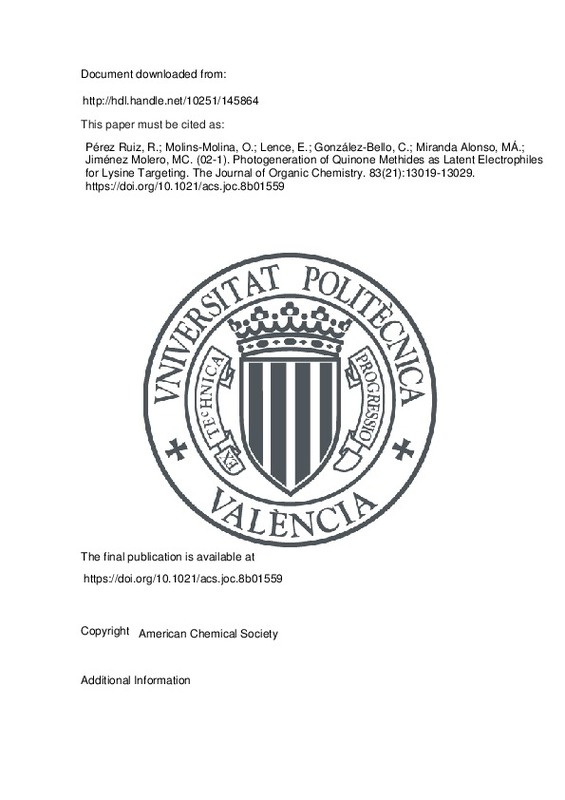Pérez Ruiz, R.; Molins-Molina, O.; Lence, E.; González-Bello, C.; Miranda Alonso, MÁ.; Jiménez Molero, MC. (2018). Photogeneration of Quinone Methides as Latent Electrophiles for Lysine Targeting. The Journal of Organic Chemistry. 83(21):13019-13029. https://doi.org/10.1021/acs.joc.8b01559
Por favor, use este identificador para citar o enlazar este ítem: http://hdl.handle.net/10251/145864
|
Título:
|
Photogeneration of Quinone Methides as Latent Electrophiles for Lysine Targeting
|
|
Autor:
|

 Pérez Ruiz, Raul
Molins-Molina, Oscar
Lence, Emilio
González-Bello, Concepción
Pérez Ruiz, Raul
Molins-Molina, Oscar
Lence, Emilio
González-Bello, Concepción
 Miranda Alonso, Miguel Ángel
Miranda Alonso, Miguel Ángel

 Jiménez Molero, María Consuelo
Jiménez Molero, María Consuelo
|
|
Entidad UPV:
|
Universitat Politècnica de València. Departamento de Química - Departament de Química
|
|
Fecha difusión:
|
|
|
Resumen:
|
[EN] Latent electrophiles are nowadays very attractive chemical entities for drug discovery, as they are unreactive unless activated upon binding with the specific target. In this work, the utility of 4-trifluoromethyl ...[+]
[EN] Latent electrophiles are nowadays very attractive chemical entities for drug discovery, as they are unreactive unless activated upon binding with the specific target. In this work, the utility of 4-trifluoromethyl phenols as precursors of latent electrophiles, quinone methides (QM), for lysine-targeting is demonstrated. These Michael acceptors were photogenerated for specific covalent modification of lysine residues using human serum albumin (HSA) as a model target. The reactive QM-type intermediates I or II, generated upon irradiation of 4-trifluoromethyl-1-naphthol (1)@HSA or 4-(4-trifluorometylphenyl)phenol (2)@HSA complexes, exhibited chemoselective reactivity toward lysine residues leading to amide adducts, which was confirmed by proteomic analysis. For ligand 1, the covalent modification of residues Lys106 and Lys414 (located in subdomains IA and IIIA, respectively) was observed, whereas for ligand 2, the modification of Lys195 (in subdomain IIA) took place. Docking and molecular dynamics simulation studies provided an insight into the molecular basis of the selectivity of 1 and 2 for these HSA subdomains and the covalent modification mechanism. These studies open the opportunity of performing protein silencing by generating reactive ligands under very mild conditions (irradiation) for specific covalent modification of hidden lysine residues.
[-]
|
|
Palabras clave:
|
Quinone methide
,
Photochemistry
,
Lysine targeting
|
|
Derechos de uso:
|
Reserva de todos los derechos
|
|
Fuente:
|
The Journal of Organic Chemistry. (issn:
0022-3263
)
|
|
DOI:
|
10.1021/acs.joc.8b01559
|
|
Editorial:
|
American Chemical Society
|
|
Versión del editor:
|
https://doi.org/10.1021/acs.joc.8b01559
|
|
Código del Proyecto:
|
info:eu-repo/grantAgreement/MINECO//CTQ2016-78875-P/ES/CONTROL SUPRAMOLECULAR DE LA FOTORREACTIVIDAD EN MEDIOS MICROHETEROGENOS BASADOS EN AMINOACIDOS: GELES MOLECULARES Y PROTEINAS TRANSPORTADORAS COMO NANORREACTORES./
...[+]
info:eu-repo/grantAgreement/MINECO//CTQ2016-78875-P/ES/CONTROL SUPRAMOLECULAR DE LA FOTORREACTIVIDAD EN MEDIOS MICROHETEROGENOS BASADOS EN AMINOACIDOS: GELES MOLECULARES Y PROTEINAS TRANSPORTADORAS COMO NANORREACTORES./
info:eu-repo/grantAgreement/MINECO//SAF2016-75638-R/ES/DESARROLLO DE NUEVOS FARMACOS PARA EL TRATAMIENTO DE LAS INFECCIONES BACTERIANAS MULTIRESISTENTES: APROXIMACIONES QUE INCIDEN SOBRE VIABILIDAD, RESISTENCIA Y VIRULENCIA/
info:eu-repo/grantAgreement/Xunta de Galicia//ED431G%2F09/
info:eu-repo/grantAgreement/UV//PT13%2F0001/
info:eu-repo/grantAgreement/ISCIII//PT13%2F0001/
info:eu-repo/grantAgreement/MINECO//PT13%2F0001/
info:eu-repo/grantAgreement/MINECO//CTQ2013-47872-C2-1-P/ES/METABOLITOS FOTOACTIVOS/
info:eu-repo/grantAgreement/MINECO//BES-2014-069404/ES/BES-2014-069404/
info:eu-repo/grantAgreement/GVA//PROMETEO%2F2017%2F075/ES/Reacciones fotoquímicas de biomoléculas/
[-]
|
|
Agradecimientos:
|
Financial support from the Spanish Ministry of Economy and Competiveness [CTQ2016-78875-P, SAF2016-75638-R and BES-2014-069404 (predoctoral fellowship to O.M.-M.)], the Generalitat Valenciana (PROMETEO/2017/075), the ...[+]
Financial support from the Spanish Ministry of Economy and Competiveness [CTQ2016-78875-P, SAF2016-75638-R and BES-2014-069404 (predoctoral fellowship to O.M.-M.)], the Generalitat Valenciana (PROMETEO/2017/075), the Community of Madrid (2016-T1/AMB-1275), the Xunta de Galicia (Centro Singular de Investigacion de Galicia accreditation 2016-2019, ED431G/09 and postdoctoral fellowship to E.L.), and the European Union (European Regional Development Fund, ERDF) is gratefully acknowledged. The proteomic analysis was performed in the proteomics facility of SCSIE University of Valencia that belongs to ProteoRed PRB2-ISCIII and is supported by grant PT13/0001, of the PE I+D+i 2013-2016, funded by ISCIII and FEDER. We are grateful to the Centro de Supercomputacion de Galicia (CESGA) for use of the Finis Terrae computer.
[-]
|
|
Tipo:
|
Artículo
|







![[Cerrado]](/themes/UPV/images/candado.png)


